
A visit by professors from the Faculty of Architecture to the K23 Tower, the tallest building in Cuba and future hotel managed by GAESA, allowed one of them to take photographs from its imposing height and share unique views of the capital.
“Once we arrived on the winch to the 28th floor, we went up the stairs to the level where the cantilevered platform is, and from there to the 42nd, 43rd floors and the roof 152 meters above the level of 23rd street (31 -40 m higher than the Focsa Building)”, he said in The architect Abel Tablada.
The hotel began construction in September 2018 and Its completion was scheduled for 2022. However, in his publication, the architect offered different start and completion dates, indicating that they began in May 2020 “right at the beginning of the pandemic” and that “they expect to conclude in June 2024.”
“As architects, we have our criticisms [but] they are more focused on the investment process, the initial decisions, the lack of public competition and the little respect for the Commissions of experts that are in charge of ensuring compliance with urban regulations and the heritage and environmental values of the city,” said Tablada.
The future hotel, whose construction was not stopped even by the coronavirus epidemic, will be accompanied by a bridge that will cross it connecting arteries 23 and 25. The real estate company in charge of the construction is Almest, a branch of the Grupo de Gestión group Empresarial S.A. (GAESA), and its capital is announced as "100% Cuban."
The facility will have 565 rooms and will be five-star category. According to Tablada, you can now visit some of them that are “in the process of completing technical networks and assembling equipment.”
“Here are some photos of the impressive views from the roof and the façade of the building,” said the architect after thanking everyone who made the visit possible.
At the beginning of the year it was known that a Cuban state company would be in charge of furnishing the gigantic tower. The Base Business Unit (UEB) Muebles Ludema, of Las Tunas, was designated by the Cuban State to be in charge of supplying furniture to the hotel.
Shortly after, a Cuban shared images from the 32nd floor and explained that he was able to do them because he is a construction worker.
Located in the so-called "hole on 23rd Street", the construction by GAESA continues to raise doubts in part of the population, who believe that will not fit into the environment because it will alter the urban planning of the city and in particular of the emblematic area on the corner of 23rd and L.
In June 2022, a specialist focused on what, as he could see from photographs, could be major and minor construction defects, as well as violations of occupational safety and hygiene measures.
Referring to the “dark spots” that can be seen in the concrete, which in the jargon of the union are known as “cockroaches”, the architect stated that these were “places to which, due to lack of vibration, the mass of concrete did not arrive and there were gaps in its surface.”
Others, like the Cuban meteorologist Elier Pila Fariñas have drawn attention to the blinding glow generated by the hotel's glass walls, which cause difficulties for drivers traveling on 23rd Street.
There are many residents of the capital who think that, although it seems like an interesting and avant-garde design, The property will not fit in at all with the surroundings. because it will alter the urban planning of the capital and much more of an area as emblematic as the corner of 23rd and L.
Popularly known as Torre López-Calleja, after the late Brigadier General Luis Alberto Rodríguez López Calleja, former president of GAESA, the hotel continues to generate controversy among Havana residents, who see its construction as a waste of public money that is not invested in services such as health or education.
What do you think?
COMMENTFiled in: